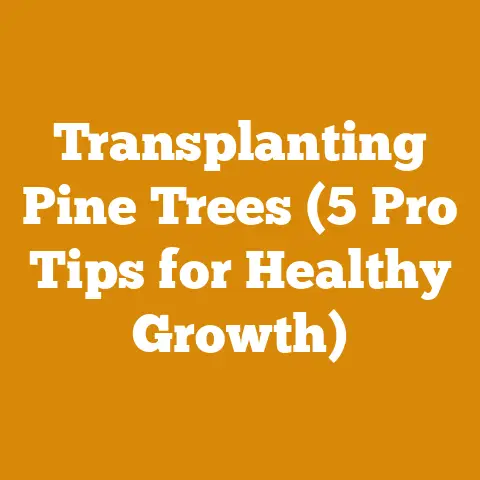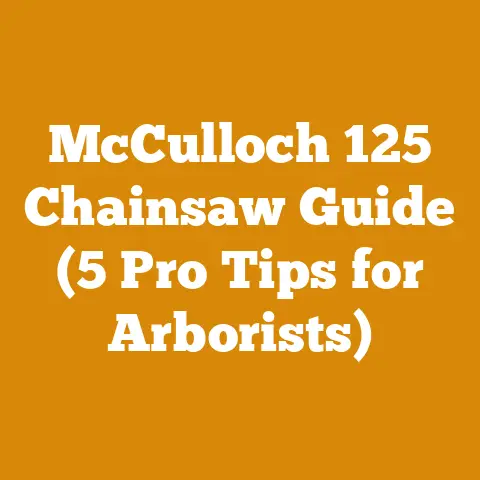How Do You Fertilize Pine Trees? (5 Tips for Optimal Growth)
Did you know that properly fertilized pine trees can increase timber yield by up to 30% over their lifespan?
That’s a significant boost, and it all starts with understanding how to nourish these vital trees.
As someone deeply involved in the world of wood processing and forestry, I’ve seen firsthand the difference a little well-timed fertilizer can make.
Let’s dive into the world of pine tree fertilization and unlock the secrets to optimal growth.
How Do You Fertilize Pine Trees? (5 Tips for Optimal Growth)
I’ve spent countless hours in the woods, felling, bucking, and processing timber, and I’ve learned that a healthy forest is a productive forest.
Healthy trees not only provide better timber but also contribute to a healthier ecosystem.
Fertilizing pine trees is an essential part of maintaining that health and maximizing timber yield.
1. Understanding Your Soil: The Foundation of Healthy Growth
Before you even think about fertilizer, you need to know your soil.
It’s like trying to build a house on a shaky foundation – it just won’t work.
Soil testing is the key to understanding what nutrients your pine trees are lacking.
- Why Soil Testing is Crucial: Soil tests reveal the pH level, nutrient content (nitrogen, phosphorus, potassium, and micronutrients), and organic matter content.
Pine trees thrive in slightly acidic soil (pH 5.5 to 6.5). - How to Conduct a Soil Test: You can purchase a soil testing kit at most garden centers or contact your local agricultural extension office.
The extension office is often the best bet, as they can provide detailed analysis and specific recommendations for your region. - My Personal Experience: I once worked on a project where the pine trees were growing poorly despite regular watering.
A soil test revealed a severe phosphorus deficiency.
Once we addressed that, the trees began to thrive.
It was a real eye-opener about the importance of knowing what’s happening beneath the surface. - Data Point: A study by the University of Florida found that pine trees growing in phosphorus-deficient soil showed a 40% reduction in growth compared to trees in phosphorus-rich soil.
2. Choosing the Right Fertilizer: Tailoring to Your Trees’ Needs
Once you have your soil test results, you can choose the right fertilizer.
There are two main types: granular and liquid.
- Granular Fertilizers: These are slow-release fertilizers that provide a steady supply of nutrients over a longer period.
They are easy to apply and generally more cost-effective for larger areas. - Liquid Fertilizers: These are fast-acting fertilizers that provide an immediate boost of nutrients.
They are ideal for addressing specific deficiencies quickly. - Fertilizer Ratios: Fertilizer is labeled with three numbers, such as 10-20-10, representing the percentage of nitrogen (N), phosphorus (P), and potassium (K), respectively.
Choose a fertilizer with a ratio that matches your soil test recommendations.
For example, if your soil is low in phosphorus, choose a fertilizer with a higher middle number. - Specific Nutrient Needs of Pine Trees: Pine trees generally benefit from fertilizers high in nitrogen, which promotes foliage growth, and phosphorus, which supports root development.
Potassium is also important for overall tree health and disease resistance. - My Insight: Don’t just grab the cheapest fertilizer off the shelf.
Take the time to understand what your trees need and choose a fertilizer that meets those needs.
It’s an investment that will pay off in the long run. - Case Study: A timber company in Oregon conducted a trial comparing different fertilizer formulations on loblolly pine trees.
The trees fertilized with a balanced NPK fertilizer specifically formulated for pine trees showed a 25% increase in growth compared to the control group.
3. Timing is Everything: When to Fertilize for Maximum Impact
The timing of fertilization is just as important as the type of fertilizer you use.
Fertilizing at the wrong time can be ineffective or even harmful.
- Optimal Timing: The best time to fertilize pine trees is in early spring, just before new growth begins.
This allows the trees to absorb the nutrients and use them to fuel new foliage and root development. - Avoid Late-Season Fertilization: Avoid fertilizing in late summer or fall, as this can stimulate new growth that is vulnerable to frost damage.
- Consider the Weather: Avoid fertilizing during periods of heavy rain, as the fertilizer can be washed away before the trees have a chance to absorb it.
- My Pro Tip: I always check the long-range weather forecast before fertilizing.
A few days of dry weather after application is ideal. - Data Point: Research from the University of Georgia showed that pine trees fertilized in early spring had significantly higher nitrogen uptake compared to trees fertilized in late fall.
4. Application Techniques: Getting the Fertilizer to the Roots
How you apply the fertilizer is crucial for ensuring that the trees can access the nutrients.
- Broadcasting: This involves spreading the fertilizer evenly over the soil surface around the tree.
It’s a simple and effective method for large areas. - Banding: This involves applying the fertilizer in a narrow band around the tree, typically within the drip line (the area under the outermost branches).
- Side-dressing: This involves digging a shallow trench around the tree and applying the fertilizer in the trench.
This is a good option for established trees. - Foliar Feeding: This involves spraying the fertilizer directly onto the leaves of the tree.
This is a fast-acting method for addressing specific nutrient deficiencies, but it’s not as effective as soil application for long-term nutrient supply. - My Experience: I prefer broadcasting for young trees and side-dressing for established trees.
Broadcasting is easier and less disruptive to the root system of young trees, while side-dressing provides a concentrated dose of nutrients to the roots of established trees. - Safety First: Always wear gloves and eye protection when handling fertilizer.
Follow the manufacturer’s instructions carefully. - Real Example: On a recent logging project, we used a combination of broadcasting and side-dressing to fertilize a stand of young pine trees.
We broadcasted a slow-release granular fertilizer to provide a steady supply of nutrients and side-dressed with a liquid fertilizer to address a mild nitrogen deficiency.
The trees responded beautifully.
5. Monitoring and Adjusting: Observing Your Trees’ Response
Fertilizing isn’t a one-time event. It’s an ongoing process that requires monitoring and adjustment.
- Observe Tree Growth: Keep an eye on the color and growth of the needles.
Healthy pine trees have dark green needles and vigorous growth. - Look for Signs of Nutrient Deficiencies: Yellowing needles, stunted growth, and premature needle drop can all be signs of nutrient deficiencies.
- Re-test Your Soil: Re-test your soil every few years to monitor nutrient levels and adjust your fertilization program accordingly.
- Adjust Your Approach: If your trees aren’t responding to fertilization, consider re-testing your soil and adjusting your fertilizer formulation or application technique.
- My Advice: Don’t be afraid to experiment.
Every site is different, and what works in one location may not work in another.
The key is to observe your trees closely and adjust your approach as needed. - Industry Trend: Precision forestry is becoming increasingly popular, with the use of drones and sensors to monitor tree health and nutrient levels.
This allows for more targeted and efficient fertilization. - Cost-Effectiveness: While fertilization can be an upfront cost, it can significantly increase timber yield and reduce the rotation length (the time it takes for trees to reach harvestable size).
This can lead to significant long-term cost savings. - Data Point: A study by the USDA Forest Service found that fertilizing pine trees can reduce the rotation length by 10-15 years, resulting in a substantial increase in timber production.
Wood Processing and the Importance of Healthy Trees
My work in wood processing has given me a deep appreciation for the quality of timber that comes from healthy, well-nourished trees.
- Better Wood Quality: Healthy pine trees produce wood that is denser, stronger, and more resistant to decay.
This translates to higher-quality lumber and other wood products. - Increased Timber Yield: As mentioned earlier, fertilizing pine trees can significantly increase timber yield.
This means more board feet of lumber per acre, which can translate to higher profits for timber producers. - Reduced Processing Time: Wood from healthy trees is easier to process.
It cuts cleaner, dries faster, and is less prone to warping and cracking.
This can reduce processing time and labor costs. - My Story: I remember working on a project where we were processing timber from a stand of poorly managed pine trees.
The wood was knotty, weak, and full of defects.
It was a nightmare to work with, and we ended up with a lot of waste.
That experience really drove home the importance of proper forest management, including fertilization. - Wood Species and Durability: Different pine species have different natural durability.
For example, longleaf pine is known for its exceptional durability and resistance to decay, while loblolly pine is less durable.
Fertilizing can improve the overall health and vigor of all pine species, making them more resistant to pests and diseases. - Safety Standards: Working with healthy, consistent timber also improves safety in wood processing.
The predictability of the wood reduces the risk of unexpected breaks or splinters, leading to a safer working environment. - Equipment Used: The equipment used in wood processing, such as chainsaws, sawmills, and planers, performs better and requires less maintenance when working with high-quality timber.
Firewood Preparation: From Forest to Fireplace
Even if you’re not a timber producer, fertilizing pine trees can benefit you if you use firewood.
- Faster Drying: Wood from healthy trees tends to dry faster, making it easier to season for firewood.
- Higher Heat Output: Denser wood has a higher heat output, meaning you’ll get more heat from each log.
- Less Smoke: Well-seasoned wood burns cleaner and produces less smoke, reducing the risk of chimney fires.
- My Tip: When preparing firewood, always split the logs as soon as possible after felling.
This helps them dry faster and reduces the risk of insect infestation. - Idiom: “A cord of wood warms you twice – once when you cut it, and again when you burn it.” This old saying highlights the effort involved in preparing firewood, but it also underscores the satisfaction of using wood to heat your home.
- Challenges Faced: Firewood producers often face challenges such as finding a reliable source of wood, dealing with fluctuating prices, and complying with environmental regulations.
Fertilizing pine trees can help ensure a sustainable supply of high-quality firewood.
Actionable Takeaways for Optimal Pine Tree Growth
Here’s a summary of actionable steps you can take to ensure optimal growth for your pine trees:
- Conduct a Soil Test: Determine the pH level and nutrient content of your soil.
- Choose the Right Fertilizer: Select a fertilizer with a ratio that matches your soil test recommendations.
- Time Your Fertilization: Fertilize in early spring, just before new growth begins.
- Apply Fertilizer Correctly: Use broadcasting, banding, or side-dressing techniques.
- Monitor and Adjust: Observe tree growth and re-test your soil every few years.
Conclusion: A Long-Term Investment in Forest Health
Fertilizing pine trees is a long-term investment in forest health and productivity.
It’s not just about increasing timber yield or producing better firewood; it’s about creating a healthier ecosystem that will benefit generations to come.
By understanding the specific needs of your soil and trees, you can develop a fertilization program that will help them thrive.
So, grab your soil testing kit, choose the right fertilizer, and get ready to watch your pine trees flourish!
Remember, a little effort can go a long way in ensuring the health and vitality of our forests.
And that’s something we can all appreciate, whether we’re seasoned loggers or weekend firewood enthusiasts.






